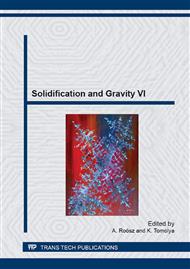p.414
p.420
p.429
p.435
p.441
p.447
p.452
p.458
p.464
Cast Iron Solidification Structure and how it is Related to Defect Formation
Abstract:
In this work, the meaning of the solidification structure and how it is related to defect formation in grey cast iron will be discussed. The work also confirms observations made earlier. In previous work the formation of shrinkage porosity in grey cast iron cylinder heads was investigated. It was found that the defect is located around solidification units resembling primary austenite grains. The solidification of grey cast iron starts with the formation of primary austenite grains, followed by the eutectic solidification. The primary grains nucleate and grow either as columnar or equiaxed grains, creating a columnar to equiaxed transition between the two zones. Based on the presence of a migrating hot spot, and other characteristics found on the cylinder heads, a geometry was developed that promote the formation of shrinkage porosity. The primary solidification structure, normally transformed during the solid state transformation, was preserved using a technique called Direct Austempering After Solidification (DAAS). After solidification, the samples were cut and prepared for investigation using a Scanning Electron Microscope (SEM) equipped with a detector for Electron Back Scattered Diffraction (EBSD). Individual grains were identified and the primary solidification structure around the defects was revealed. The investigation shows how shrinkage porosity is formed and located between primary austenite grains. This confirms that the primary solidification structure has a large influence on the formation of defects in grey cast iron. The investigation also confirms the correctness of earlier results as well as the validity of the DAAS technique.
Info:
Periodical:
Pages:
441-446
Citation:
Online since:
May 2014
Authors:
Price:
Сopyright:
© 2014 Trans Tech Publications Ltd. All Rights Reserved
Share:
Citation:


